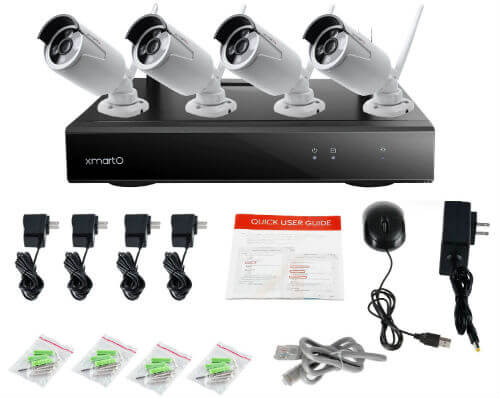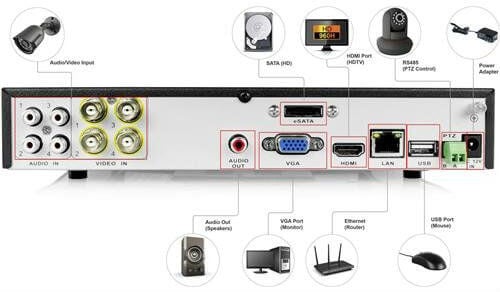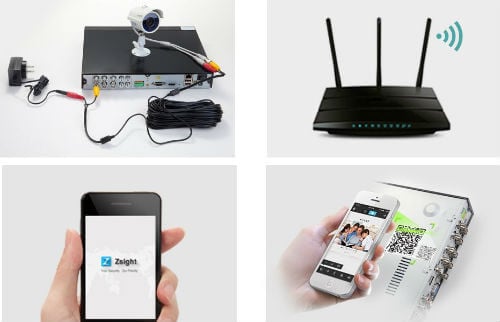The home security system comprises of Security Cameras, DVR System, and the Control System to integrate all these parts. Expensive devices are coming with built-in Wi-Fi cameras that avoid complicated wiring between the Control unit and cameras. The security systems have become more and more advanced over the past couple of years as they incorporate several features such as the motion detector systems, night vision cameras, and wireless cloud storage abilities. These systems are now compatible with your smartphones as well to keep you notified about the security of your house all the time and let you watch any corner of your home anywhere from the world on your smartphone. Here we present to you six factors that you should keep in mind before buying a new Home Security Camera System:
What is coming with Home Security System?
The primary thing, when you purchase a single security camera for a room or your doorstep, it is highly advisable to buy an entire protection system with all the essential components enlisted below, to get the maximum security for your house. Image credit: amazon.com When you select a security system for your home, please make sure the system comes with Security Cameras (to watch your rooms), Digital Video Recorder (to record Camera output Video and Audio) and Video Cables (to connect Cameras and Monitor to DVR). You must get the Power supply with Splitter Cables (for DVR and Cameras) and USB mouse and a Quick Setup Guide (optional) along with this. The DVR system should have all connectors to integrate the Cameras and Monitor Screens in additional to the internal storage device, typically a hard disk with memory in Terabytes.
Number of Channels on Home Security System
The number of channels in the security system you buy decides how many numbers of cameras or other devices such as smartphone or tablet can you connect to the control system to monitor your house. For example, a four channel security system allows you to connect only four cameras simultaneously to the security system. How to decide how many channels you need, you ask? Well, the answer is simple the number of cameras/channels is necessary for your house depends entirely on the size of your home. For example, if you have four bedrooms and two floors in your house, it is advisable to buy an eight channel security system to install one camera in each room, one camera at the entry of the house, 1 in the living room and two at different random spots. Initially, you don’t need to buy eight cameras. But with an eight channel system you can upgrade up to eight cameras if required in future.
Home Security System Camera Types
At the end of the day, the most important component of your security system is the security cameras. The type of camera that you select determines the recording quality and the place where intent to use those cameras. Image credit: amazon.com The cameras nowadays come with a ton of unnecessary features, and hence you might want to judge the surroundings of your house and choose the camera type accordingly. Typically, a high-quality home security camera coming with 1080p HD recording (better resolution better quality) with some optional features such as Motion Detector, Night Vision, Face Detection, Video & Audio Recording, Weather Proof (airtight against dust and able to endure any wind and rain), etc. You can read more about Things to Consider before Buying an IP Security Camera.
Security System Recorded Video & Audio Backup Storage
The backup hard disk and other storage devices that you need to buy with these security systems, or in some cases come inbuilt with them, are a significant factor for you to determine how long you need to archive the recorded information. Image credit: amazon.com Typically, these storing drives are conventional hard disks with a storage size range from 500 GB to over 3 TB. When you consider 500GB hard disk, you can save the video for the entire day with HD Quality where 3TB will offer to save up to one-week worth data. If you are not worried about HD Quality of video, you can save in low-resolution videos that can record 30-50 days worth of data on a 3TB drive before running out of storage. The DVR system overwrites the data on top of the old video once your hard disk gets full unless you mark some information as Do Not Delete for future reference.
Security System Connection between Central System and Security Cameras
There are two ways by which the central console system of your home security system can connect with your security cameras, wired or wireless. Both of these systems have their pros and cons. Wireless systems are convenient to set up, place any location of your home you want if you have a power cable near to that are. In high-end security system devices, all camera channels are connecting via HTTPS encrypted protocol. Using the wireless camera system, you can ensure easy setup, but the range for this type camera is limited to few hundreds of feet. Unless you have a Wi-Fi repeater installed at your place to enhance the range of your Wi-Fi connection this system is not efficient for a large house. Image credit: amazon.com While we see that the wired system has more extended range compared to the wireless system, it is quite difficult to reach out to the corners of your house to install with both video and power cables. You do not want the aesthetic appeal of the home to be destroyed by wires running all over the house, do you? The choice of wireless or wired means of communication comes down to be decided upon by the size of your home.
Home Security System Monitoring Devices
These systems also come in with a display monitor capable of displaying several screens at a time, each screen showing the view by a separate channel. You can connect the monitor display using the video cables. For Wi-Fi-based home security system, you can monitor the channels on any computer via the web browser and a dedicates IP address. Image credit: amazon.com In addition to this, the videos and audio can be live streamed onto a smartphone screen as well by means of dedicated applications or Internet Protocols (IP) provided by some manufacturers, that let you watch any corner of your home on the smartphone.
Home Security System Advanced Features
The modern home security system has not only become more efficient but has become smart as well. With the ability to interact with smartphones, tablets, and laptops these security systems keep you updated about the security status of your house. These smart home security systems can contact you by itself in the form of email notifications or mobile push alerts when a credible risk is detected like motion detectors or housebreak. image credit: amazon.com The security of your house is one of the most primary concerns in your life and to ensure that you always have the best of security without human interference, a home security system is must protect all your valuable assets. With Smartphone and other smart human recognizing algorithms, these systems are getting smart day by day that can identify people whom you trust with your belongings and distinguish them from threats using facial recognition software. HD recording, a ton of memory (in terabytes) to store videos worth for a couple of weeks or month, weatherproof nature and wireless operation are the technological advancements that allow this system to be installed quickly anywhere in your house.
Δ









